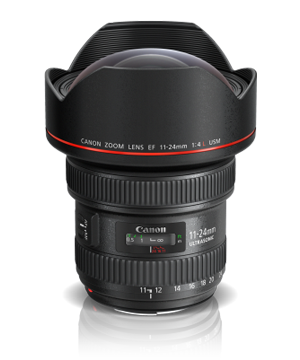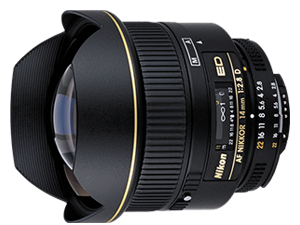This week, we are going to dive into the use cases and deliverables of wide-angle lenses.

What makes a lens wide-angle?
There’s no fancy Latin etymology that defines a wide-angle lens. Simply, any lens with a reasonably larger angle of view than the 50mm prime lens on a full frame sensor is referred to as a wide-angle. In earlier days we called the 50mm the “standard” lens because it provides the same relative magnification as the human eye. The following table shows the apparent magnification of some popular wide-angle focal lengths.
| Full Frame Focal Length | Apparent Magnification |
| 50mm | 1x |
| 35mm | 0.7x |
| 28mm | 0.56x |
| 24mm | 0.48x |
| 20mm | 0.4x |
| 18mm | 0.36x |
| 15mm | 0.3x |
| 14mm | 0.28x |
| 11mm | 0.22x |
Using the full frame sensor as example, we see that a full frame with a 50mm lens sees with about the same magnification and perspective as the human eye. From this knowledge we can then infer that any lens with a focal length of shorter than about 50mm becomes wide-angle. Fortunately, as in the telephoto, the relationship between focal length and relative magnification is pretty much linear. Thus a 24mm lens makes the subject look just over twice as far away as does a 50mm, while a 12mm lens makes the subject look four times farther. With telephotos we choose a focal length to bring subjects closer. With wide-angles it is less about “pushing” the subject away than showing us more of the overall subject area. We want to see more edge to edge and are less interested in the specific detail of a single subject.
We therefore consider the angle of view presented by the lens. The shorter the focal length, the wider the angle of view that the lens presents. This means that as the subject appears to move away, the amount of surrounding area is increased, meaning that it appears we are moving further out from the edges of the image that we saw with our 50mm example. The table below helps understand the apparent magnification and angle of view for different wide-angle focal lengths and the impact that sensor size has on these.
| Focal Length | Sensor | Angle of View (Diagonal) |
| 50mm | Full Frame | 46.8° |
| 50mm | Nikon/Sony/Fujifilm APS-C | 32.2° |
| 50mm | Canon APS-C | 30.3° |
| 50mm | M43 | 24.4° |
| 24mm | Full Frame | 84.1° |
| 24mm | Nikon/Sony/Fujifilm APS-C | 62.0° |
| 24mm | Canon APS-C | 58.8° |
| 24mm | M43 | 48.6° |
| 11mm | Full Frame | 126.1° |
| 11mm | Nikon/Sony/Fujifilm APS-C | 105.3° |
| 11mm | Canon APS-C | 101.6° |
| 11mm | M43 | 89.0° |
We see in the table, that a smaller sensor with the same physical focal length provides a smaller angle of diagonal view and thus a greater apparent magnification. This is one of the reasons why cameras with smaller sensors are used less by photographers looking to create sweeping vistas, or to create the illusion of interior space in real estate photography.
As I mentioned in the past, focal length is based on the distance from a measured point in the lens to the focal plane where the sensor resides. For DSLR cameras, we measure the same focal lengths regardless of full frame or APS-C sensor sizes but because the smaller sensor sees less of the image being produced, we get the illusion of enhanced magnification. That’s why a 24mm full frame lens used on a Canon APS-C sensor has the look of a 38mm lens.
| Sensor Size | Crop Factor/Apparent Magnification |
| Full Frame | 1.0x |
| Nikon/Sony/Fujifilm APS-C | 1.5x |
| Canon APS-C | 1.6x |
| Micro Four Thirds (Olympus, Lumix) | 2.0x |
Unlike with telephoto lenses, until recently there has not been the same demand for wide-angle lenses with very large maximum apertures. wide-angle lenses tend to be used for expansive subjects, where the larger concern is field of view and the ability to manage depth of field than to bring in lots of light. Because larger apertures mean bigger lenses, we pay a premium for very fast lenses in size, weight and cost. Because wide-angle lenses have more depth of field at a given focal length and aperture than a standard or telephoto lens, some photographers choose very optically fast wide-angle lenses to obtain the ability to have shallower depth of field.
| Canon 24mm f1.4L II USM | Canon 24mm f/2.8 IS | |
| Focal Length | 24mm | 24mm |
| Maximum Aperture | f/1.4 | f/2.8 |
| Shake Reduction | NO | YES |
| Fits Full Frame? | YES | YES |
| High Performance Multi-coating | SSC | SSC |
| Weight | 22.9 oz (1.43 lbs) | 9.88 oz (0.6 lbs) |
| Retail MSRP (Canada) | $1,959.95 | $679.95 |
As you can see from the preceding table, for a bump of two f stops of light transmission, we find an increase in size and weight of over two times and a cost increase of nearly three times. This is why matching the lens to the use case is so important.

Canon’s amazing 11-24/4 Wide-Angle Zoom
Just as with telephoto lenses, it used to be that wide-angle lenses only came as fixed focal length lenses and if a photographer wanted different angles of view. Now of course, we have many choices in wide-angle zoom lenses. Some offer very wide-angles of view such as Canon’s stunning 11-24mm f/4 or Nikon’s 14-24mm f/2.8. When we choose lenses with such extremely wide-angles of view, vendors like to refer to these as ultra-wides. Shooting an ultra-wide lens requires much more attention from the photographer. If the sensor plane is not parallel to the image plane, unpleasant effects such as vertical lines tilting in or out, or buildings appearing to fall over come into being. This is a natural effect of the wide-angle and is NOT a fault or distortion. Even regular wide-angle lenses and wide-angle zooms require compositional care on the part of the photographer. Some now include shake reduction, although as each part of the image takes up fewer capture pixels, there is a school of thought that this is more marketing than value. Opinions vary.
To deal with the increased risk of distortion, manufacturers must use special glass types and grinds just as they do with telephoto lenses. When manufacturers construct lenses they must deal with the realities imparted by the physics of light. Glass, even really superb optical glass, tends to disperse light rays. While the dispersion impact on focus can be corrected with grinding patterns, loss of contrast is better corrected by using special glass formulations, often referred to as Extra Low Dispersion glass. Another serious concern are true optical distortions. While distortions can exist in any lens, we have seen more distortions in poor quality wide-angles than elsewhere. This is visible in the image where the outside edges look bowed out, and vertical lines are curved. This is called barrel distortion and if at a visible level, is indicative of poor lens design. All high quality lenses also benefit from multi-coating to help deal with how different wavelengths of light bend differently in lenses.
It used to be that wide-angle zooms did a decent job in managing distortions but with the advent of the “one lens for everything” desire, we saw manufacturers start to build lenses, first for their crop sensor cameras, with focal length ranges of 18mm to 200mm in a single lens. This sounded wonderful but for years these lenses were really quite horrible in terms of overall image quality. Things have improved in recent years and we see very good wide-angle to telephoto lenses in the 16-300mm and 28-300mm ranges.
Because wide-angle lenses see such a wide-angle of view, photographers are often encouraged to shoot them at shutter speeds too slow for shake free handholding. This has prompted the addition of shake reduction technology, but photographers should also remember that we all have a resting pulse rate and that is imparting some movement as well, so while the guidelines would suggest that the safe handholdable shutter speed for a 15mm lens would be 1/15 of a second, practicality says likely not. Just as with telephotos, some wide-angles cannot accept a front mounted filter at all, you can see this in the image of the Nikon ultra-wide here. However, all wide-angle lenses can take, and most come with, a lens hood. Using a wide-angle without a lens hood is a bad idea, as you invite glare and risk damage to the front element.
One of the wonderful aspects of using a wide-angle, is the illusion of perspective expansion. It doesn’t actually happen, it’s just how we are seeing the image circle. Regardless, it’s awesome. By using a wide-angle, the perspective exaggeration makes vistas look larger and wider. Just as a telephoto image from an overpass makes a highway look jam packed due to perspective compression, a wide-angle image of a beach, lake and mountains makes the scene look majestic and huge. To make sure you achieve this effect, always try to have something of recognizable size in the foreground as this really helps the viewer get the sense of space.

If you shoot landscapes, home interiors, furniture, or find yourself in the situation that you cannot back up far enough to get everything you want in the frame, then a wide-angle lens is going to be an asset to your photography. Pick the focal length and the lens maximum aperture to suit your use cases and your budget, and you will be well along the way to making more photos that you love. Some of the early masters of street photography only ever used a 35mm wide-angle lens because it gave a nice environmental spacing to their work.



